If you missed our latest webinars on how to succeed with Google Ads, you’re in luck. We’re covering expert Google Ads tips straight from Google and our in-house experts. Plus, we’ll dive into all the latest updates and trends your business needs to know.
If you’re asking “what updates?” you’re not alone.

Trying to keep up with the latest Google Ads trends can sometimes feel like this!
Many business owners have been feeling this way about the latest changes from Google Ads. We’ve seen a ton of updates come our way, but it can be challenging to keep up and connect them back to your business’s bottom line. The ever-changing Google Ads platform has raised questions like:
- Can Google Ads be profitable for your business?
- What Google Ads tips or best practices should your business be aware of this year?
- Which Google Ads updates could impact your business?
This complete breakdown of the latest Google Ads tips will answer all that and more. Plus, we’ll be adding exclusive insights from our Google Ads experts!
Why is Google Ads important for your business?
Before we get into our Google Ads tips, you’re probably wondering whether Google Ads is guaranteed to be a profitable strategy for your business. The short answer? Yes! In fact, 93% of online experiences start with a search. When you’re promoting your business on Google Ads, you’re placing your business at the forefront of the buyer’s journey.
Our in-house Google expert and Senior Director of Partner Development, Erin Rose, explains further:
“We’ve found that Google is the first place people go for everything. Generally, the consumer buying journey both starts and ends with a search. People bounce around between a lot of different channels, but search is a cornerstone in our lives today.”
Related: Get the latest Google Ads updates to know here.
10 insider Google Ads tips you need to know
A strong local PPC strategy means an even stronger marketing ROI for your business. Use these hot Google Ads tips to stay on top of the latest and greatest within the search space:
1. Look at your search marketing holistically
As a busy business owner, you might not always have the time or resources to dive into a ton of different marketing channels at once. However, combining your strategies to work better together can be a win-win for both you and your business.
For example, you’ll find that many of the keywords, content, and audience insights you leverage across both the nonpaid and paid spaces of Google are the same. For a well-rounded strategy, you’ll want to be running local SEO along with your Google Ads efforts.
Erin expands on this:
“SEO and PPC absolutely work hand in hand. The homepage of Google is the most valuable real estate in the digital world. Look at the composition of the Google homepage. There are pieces that are both organic and paid. Think about how you want to activate those bigger business goals.
Search Ads turn the faucet on where you can immediately get high-quality traffic. SEO is more like climbing a mountain where it takes time as you act on your content strategy. Both work together to meet your short and long-term goals as one is fast while the other is a slow and steady approach.”
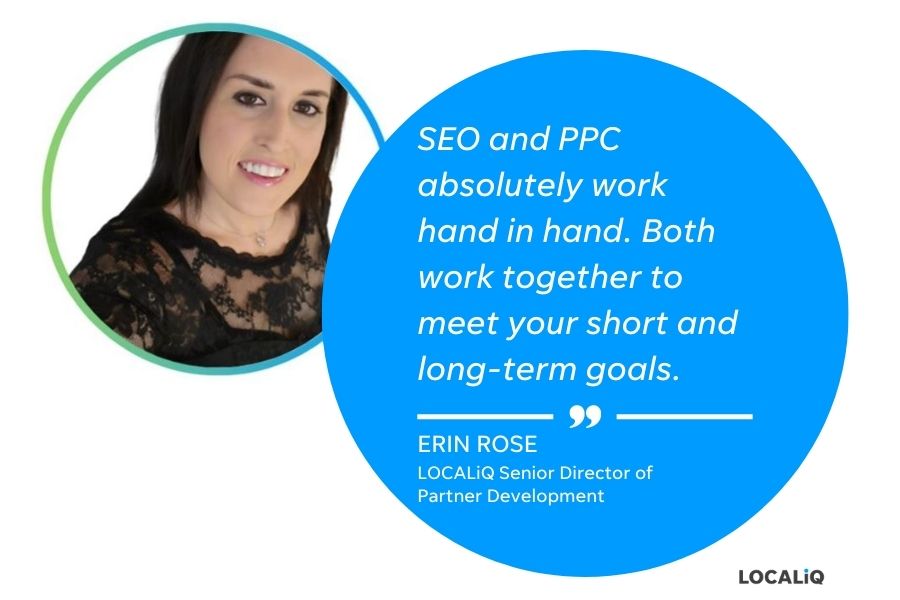
2. Routinely update your keyword research
While your Google strategies will always be a part of your local marketing plan, the keywords you target may be evolving.
We’ve seen this with the emergence of cross-device searches. Curious customers may verbally ask their home’s personal device a question while looking up something entirely different on their mobile phones or tablets. That’s why you’ll need to be ready to adjust your local keyword research according to search trends.
Our dedicated Premier Partnership Manager at Google, Jenna Zeidan, provides data to back this:
“To give you some perspective, there were 8 billion Google-connected devices in 2017. That’s more devices than there are people. But last year in 2021, that figure was closer to 27 billion. That’s growing by a million new devices every single hour. Every day, 15% of searches have never been seen by Google before.”

Jenna reiterates the fact that people are changing the phrases that they put into the search bar based on their current on-the-go needs.
To ensure your keyword research practices stay current, be sure to save this handy image below (and get our keyword research template!):
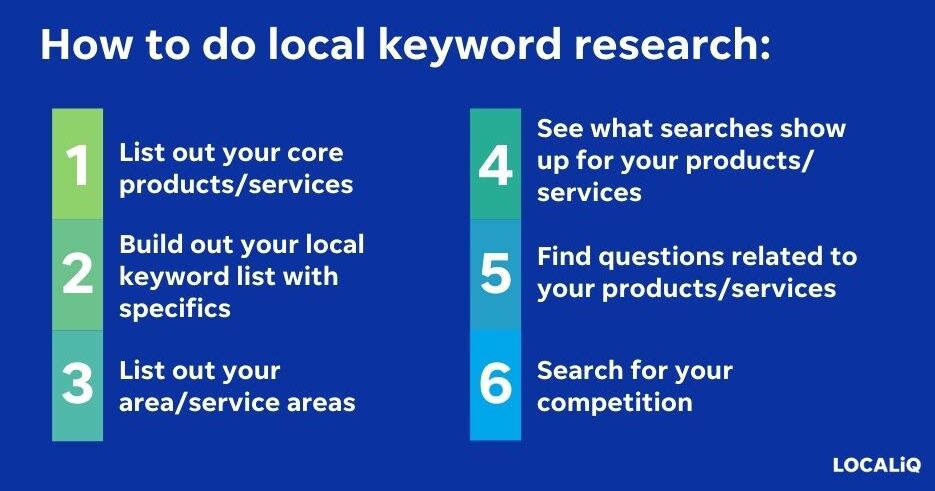
3. Be aware of industry trends
As you choose your keywords to keep up with the evolving space, the KPIs you look at may change too. For example, click inflation may impact any new or old keywords you use within your Google campaigns since costs across industries ebb and flow. As you check in on your keyword research, you should also look at our search ad benchmarks to help plan out your costs on the platform:
Related: Get tips for better marketing during inflation.
4. Check your website
There are three reasons you want your small business website to match your current Google strategies. First and foremost, landing page experience matters. Your search ad may make the first impression on a viewer and entice them to click, but your site is what seals the deal.
Additionally, when your website’s page quickly loads up relevant information, your ad’s Quality Score will be positively impacted. This can help you rank higher in the search results later because Google recognizes that you’re providing a positive experience for searchers.
Lastly, many of the updates we’re seeing on the Google platform relate to automation. Google’s machine learning can use information from your site to help guide you through creating relevant ads.
Try using free website grader tools to ensure your page is loading quickly and including all the right keywords you need to make an impact on the search results page.
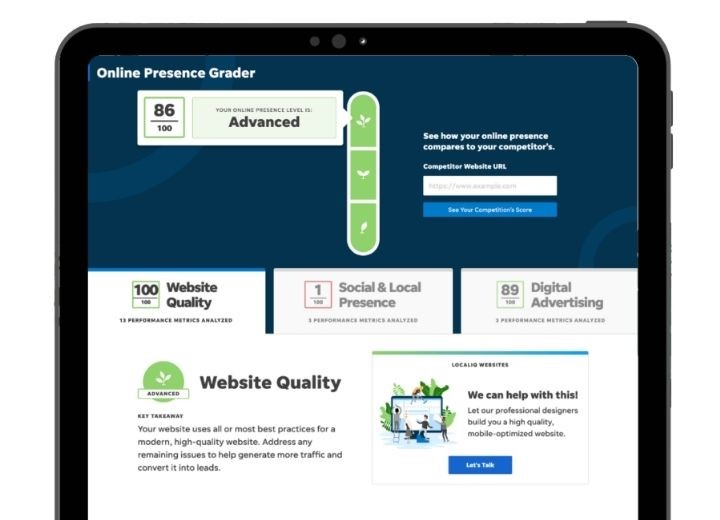
An example of a report from LOCALiQ’s website grader that can help you make the most out of your Google Ads strategy.
5. Keep up with Google Ads trends and updates
As the Google Ads platform continues to be updated, it’s important to find an easy way to keep up with any changes. Whether that be checking in on industry resources, attending events, or leveraging a marketing partner for information, you’ll want to be conscious of how Google Ads updates could impact your business’s strategy.
For example, Google Marketing Live is an annual event that runs through major Google Ads changes. We break down this year’s Google Marketing Live details here, but check out this quick list of some of the most important Google Ads updates to be aware of:
Budget pacing
The Insights page within the Google Ads platform now has a budget pacing tool that is sure to come in handy for businesses with tight budgets. The new feature suggests budget optimization tweaks based on how your spend is pacing against performance. Plus, it acts as a great visual for your projected costs and allows you to act quickly as needed.
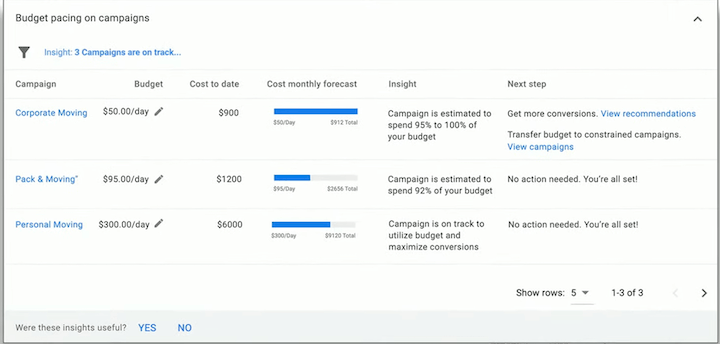
New audience options for OTT ads
Over-the-top (OTT) streaming ads appear before, after, or during shows on streaming platforms. For businesses taking advantage of this video marketing strategy, new audience options from Google have become available.
While there were always targeting options for this ad type, like location and more, Google added three more audience buckets. Now, affinity, in-market, and demographic audience types are additional targeting options for these campaigns—which make it easy for businesses to quickly use these templated audiences to target folks that meet certain behavior criteria.
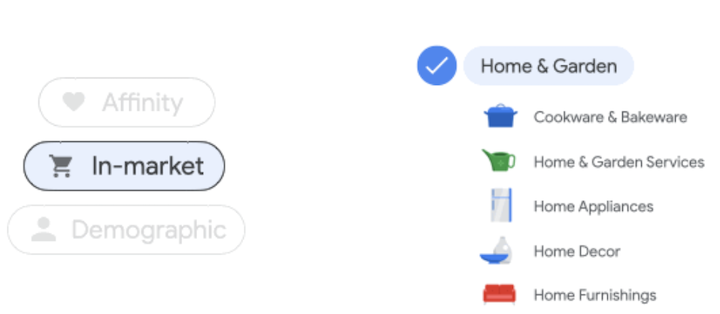
An example of how you might choose to show your OTT ads to people actively looking for home and garden products or services.
Chat messaging features in ads
For businesses that already have a Google Business Profile listing, this update provides a good reason to also use Google Search Ads. Customers can message businesses directly in Search ads via Google Business Messages.

The sunset of Expanded Text Ads
As of June 2022, Responsive Search Ads (RSAs) are the default ad type for Google Search ads. Expanded Text Ads (ETAs) were the old standard text ad type that had three headlines and two descriptions locked into place. While businesses still have the option to enable, pause, or remove ETAs, RSAs now take the spot as Google’s recommended ad type for Search campaigns.
RSAs cycle through up to 15 headlines and four descriptions. However, RSAs only show one to three headlines and one to two descriptions on the search results page—just like ETAs. That means that the two ad types look identical to users. So, this update has no impact on how your ad looks in search results—other than RSAs potentially being more relevant.
RSAs shuffle through those headline and description options to show the best possible ad to users in real time. We break down everything you need to know about this change in our ETA update article, but Jenna from Google gave us additional context:
“We want to make the ads as applicable to the searcher as possible because we know they’ll then be more likely to click the ad. Google can evaluate tens of thousands of possible ads in a fraction of a second to show a more relevant message for each individual based on context and intent signals. This change helps businesses to simplify ad creation and drive performance by ensuring you show the most relevant ad. We’ve found that switching from ETAs to RSAs see an average of 7% more conversions at a similar cost per conversion.”
6. Keep your strategy flexible
The few updates we mentioned above prove how Google continues to evolve. So, you’ll want to treat your business’s Google Ads strategy as a living, breathing project.
Don’t be afraid to make occasional changes when necessary. While you shouldn’t be toying with your account every day, it is important to hold yourself accountable with a regular check-in schedule to identify areas for optimization.
🛑 Want deeper insight into how your Google Ads are performing? Try WordStream's Google Ads Grader for an instant (and FREE!) audit of your account.
7. Embrace automation
While it can feel scary to give up control, artificial intelligence (AI) marketing is growing in popularity. There are plenty of opportunities to execute automated strategies within Google Ads.
For example, you may let the platform do the heavy lifting for you with a fully automated campaign. Or, you may just be taking advantage of Responsive Search Ads that are simply optimizing what you create using Google’s machine learning.
While there is no right or wrong answer on how much control you prefer to hand over to Google’s algorithms, you’ll want to try to find a sweet spot that incorporates automation in a way that works for you. Plus, you can always be hands-on in other ways while leveraging automation. For example, you may manually handle your reporting or optimization tests.
Jenna reiterates this:
“Brands need to embrace a digital transformation through automation.”
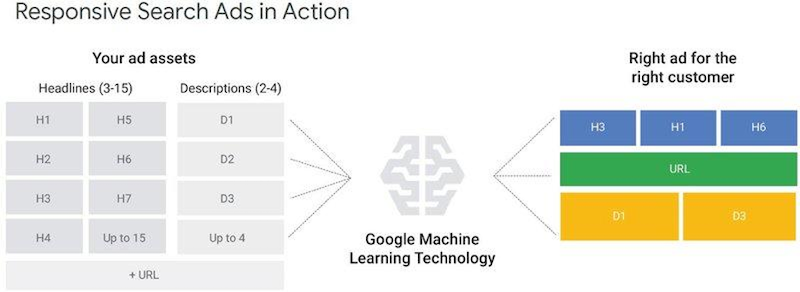
An example of how Google’s automated RSAs work for your business.
8. Double-check the details
As you transform your Google Ads strategy to meet your customers’ needs this year, you don’t want to let the details slip through the cracks. A need-to-know Google Ads tip is that it never hurts to double-check your campaigns to ensure everything is set up correctly.
For example, let’s say you’re refreshing assets you’ve used in the past. This time-saving strategy doesn’t come without risk. You could be accidentally promoting the wrong landing page or an outdated product. You may even want to check on high-level settings, like your billing information, to avoid any marketing mishaps.
9. Be ready for first-party data
It’s no secret that third-party cookies will be going away by the end of 2023. That being said, just hearing the terms “third-party cookies” and “first-party data” can be overwhelming. However, you don’t have to be a technical wizard that knows all the details of this to profit from Google. Simply learning the first-party data basics is all you need to set your business up for search success in 2022 and beyond.
Here’s a quick and easy breakdown of what all these privacy changes mean:
- Third-party cookies come from various sources to collect and store data about a consumer’s journey across the web.
- First-party data is collected by your organization and tracks consumers’ behavior directly on your website.
The purpose of both these data sources is basically the same: provide your business with key information about your audiences so that you may make marketing strategy decisions accordingly.
Third-party cookies will no longer be possible to use in the coming months due to ongoing efforts for a privacy-first web experience for all. You’ll need to rely on other data sources, like first-party data, to continue your optimization efforts.
Jenna sums this up nicely:
“First-party data is the data you hold as a company. So, it’s information you already have. All this data you hold is powerful because it will become harder to track people via third-party cookies as the landscape moves towards privacy-first strategies.
That third-party data is getting more difficult to rely on, so we want to encourage businesses to leverage the data that already belongs to them. Many folks might have a CRM where they’re tracking their qualified leads or closed sales, so we make it easy to import that data into Google.”
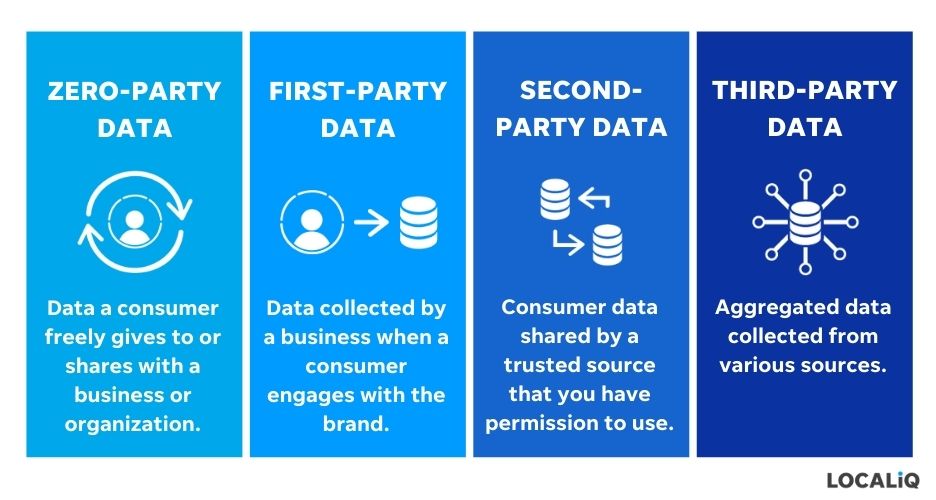
10. Have patience
The hardest part of PPC is patience! If there’s one Google Ad tip we can take note of for this year and beyond it’s that the Google space is constantly changing. That means it may take time to see your desired results. That’s totally okay!
Try to set time-frame expectations with each marketing metric you look to achieve with Google and benchmark your progress along the way to ensure your business sees success with Google in the long run.
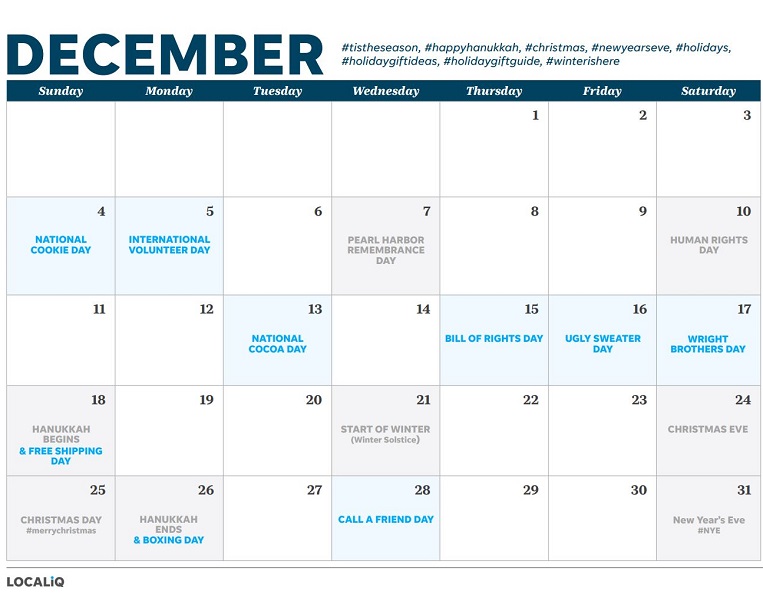
An example of a marketing calendar that can help you keep track of your Google Ads pacing.
Use our Google Ads tips to give your strategy a facelift
Time to take these Google Ads tips and run with them! If you feel like your Google Ads strategy needs some extra TLC, LOCALiQ is here to help.
Erin and Jenna agree!
“You’ve already decided that this is important enough to take time out of your day to learn more. To make the most value out of this information is to apply these concepts to your business. The good news is you don’t have to do it yourself. We’re happy to help you along the way.” -Erin
“As fantastic as Google’s tools may be, you know your customers better than anyone. You now have the opportunity to engage with them and delight them in more meaningful ways than ever before. The question then becomes: ‘how are you working with LOCALiQ to ensure your brand is best prepared?’” -Jenna
To recap, here are our top 10 Google Ads tips:
- Look at your search strategy holistically
- Routinely update your keyword research
- Be aware of industry trends
- Check your website
- Keep up with Google Ads updates
- Keep your strategy flexible
- Embrace automation
- Double-check your account details
- Be ready for first-party data
- Have patience








